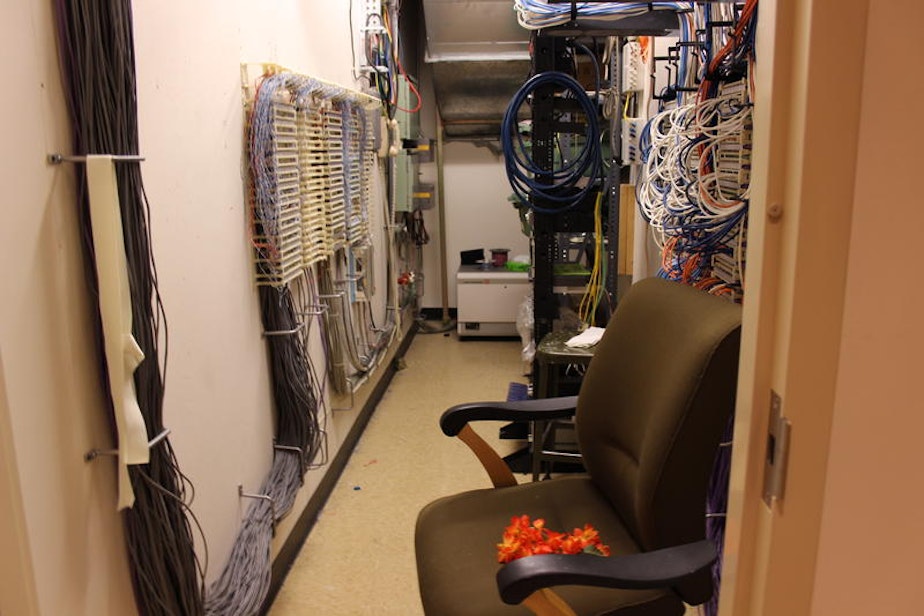Slideshow: Lactation Rooms Around Seattle (And Beyond)

When I returned from maternity leave earlier this month, my boss Jenna showed me to the lactation room.
The room, a space given to KUOW moms years ago, doubles as a narrow network room. Red, blue and yellow wires crawl up the walls, and a beige extension cord for plugging in the pump hangs from the ceiling. In the middle of the room is a broken, 1970s-style office chair stained with old splotches of breast milk.
My favorite part: The bright orange, plastic Hawaiian lei we hang on the door so the station engineers know not to enter.
It is, to quote a colleague, “funny/sad.” And it is also up to code. The Affordable Care Act has required since 2010 that employers provide pumping moms with a private space with a locking door. (That space may not be a bathroom. As you can see in the slideshow, several employers violate the law.) The health care law also requires that insurance plans contribute to the price of a pump, which can cost hundreds to thousands of dollars. These laws indicate that the federal government has made breastfeeding a priority. The Academy of American Pediatrics recommends that lactating moms nurse until their child is a year old, and the mere act of pumping helps a mom produce milk. Not pumping for a full day could reduce a mom's supply.
Dr. Wendy Sue Swanson of Seattle Children's Hospital argues that decent conditions improve a woman's chance of breastfeeding after she has returned to work.
“We know that the experience or the availability of a worksite lactation facility may change breastfeeding success," Swanson told me, referring to this study in Pediatrics. "We know it’s hard for women to continue breastfeeding when they go back to work and we know women who go back to work early have less success.”
Sponsored
Returning to work got me thinking about where other moms pump. I asked women to submit photos and received dozens of images, many of them showing that employers aren't meeting federal law. Several moms pump in their cars, and many pump in bathrooms. A surprising number of those who submitted images are doctors, pumping behind screens and in exam rooms. Moms at Nordstrom, Microsoft and Amazon are among the lucky: Those corporations provide quiet rooms with comfy chairs, desks, sinks and refrigerators. (Rumor has it that Starbucks has hospital-grade pumps at its corporate offices, but the coffee giant refused to help me out.)
I shared several of the images with Swanson, who blogs under the handle Seattle Mama Doc.
“That looks like an awful place to pump,” Swanson said, when I showed her where I pump. “I believe that it’s private, but it sure looks a lot like a closet or an electrical closet, which in some ways doesn’t inspire me to think that you’ll be really relaxed or have great let down and get as much milk out as you can in the 12 to 15 minutes that you lock yourself in there.”
Times have improved, as several moms at KUOW remind me. One mom said she pumped in an office in front of a coworker. Others pumped in recording studios, papering the windows each time before they pumped.
Several of you told me your stories from before health care reform. Rhonda DiCostanzo told me that in 1980, when she was a linguist in the Army, she had to express into plastic baggies, which she stored in a kitchen fridge. The head cook “accidentally” threw out her milk. Another woman, a local organic inspector, pumped in her car between farm inspections.
Sponsored
“We’re moving the needle,” Swanson said. “We’re creating better spaces and places, but there’s no question that it’s really hard, even as a pediatrician and strong vocal feminist woman, to demand a different place than what was offered to me the first time around.”
As Swanson noted, it's tough to ask for a better space — or any space at all. Many women sent me photos but asked me not to include their names or where they work because they don't want to get in trouble. "It’s nerve-wracking to bring up the inadequacies of these rooms or the trouble with these rooms," Swanson said, "when we already feel thankful for the break, even though it’s federally legislated, and we feel thankful for the space."
Update, Thursday, June 5:
We've received nationwide feedback since this story was published. One livid grandmother reported that her daughter, who works for a Washington state agency, has to ask coworkers to loan her their offices so that she can pump throughout the day. On the other end of the spectrum, an Army officer at the Pentagon told us that the lactation rooms there are very nice, complete with a code-locking door and hospital-grade pumps.
And at Swedish Hospital, Clay Holtzman called to say that the women who pump in the shower stall should be in touch with their managers and human resources to get better accommodations. "There’s no reason why their needs can’t be accommodated," Holtzman said. "Our policy protects their rights."

